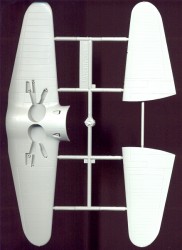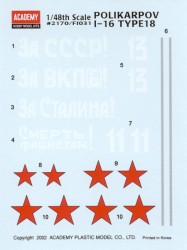Academy 1/48 Polikarpov I-16 Type 18 |  | Background Polikarpov's design signature during the mid and late 1930s was stubby, barrel-shaped fighters. The primary machine during that era was the I-15 biplane. Like their barrel-shaped brothers on the other side of the world, the Grumman F3Fs, the I-15 was going to be transformed almost directly into a monoplane fighter, the I-16. In the transformation, the I-15's upper wing was deleted and the lower wing moved up to almost a mid-fuselage mount. With a wingspan one meter shorter than the I-15, the early I-16 was powered by the same 700hp M-25 radial engine as the late-model I-15. The I-16 also incorporated retractable landing gear. Armament for the early I-16 was a pair of 7.62mm machine guns The I-16 saw combat on two fronts in the late 1930s, first in the Spanish Civil War and later with the Chinese against Japan. In Spain, the early Bf 109s flown by the Nationalists were surprised by the agile I-16 and suffered losses to the 'Rata' (Rat) as they nicknamed it. The Japanese forces were also surprised by the agile I-16 until they finally discovered and exploited the I-16's weaknesses. By the time the Nazi violated the peace treaty between the Soviet Union and Germany, the I-16 was obsolete. Nonetheless, the I-16 soldiered on into 1943 before being completely phased out of service. One of the most famous tactics flown by Soviet pilots in 1941 was ramming their I-16s into the tails of German aircraft, then either limping back to base or parachuting to safety. The Kit Academy has released the I-16 Type 18 in 1/48 scale. While nearly identical to the Hobbycraft kit, the Academy offering has all of the parts for the various versions of the I-16 included in one box, including the winter skis, updated cowl faces, rocket rails and a tailwheel. Though some of these parts were only used on other types of the I-16, you have the flexibility to build any version of the Rata you'd like.   
The kit is a simple build, with the parts molded onto three trees of light gray styrene. One small clear windscreen is also provided. Detailing is scribed and nicely done. Many of the parts are optional, making the painting of this aircraft more complex than assembly. There are no fit problems with this kit, and though the cockpit detailing is a little sparse, it is difficult to see into the cockpit once the kit is assembled. One solution is to cut out the entry door on the left side of the cockpit and pose it open. That will make any detailing you chose to perform in the cockpit much easier to see.  Markings are provided for two aircraft: Markings are provided for two aircraft:
I-16, 72nd Aviation Regiment, Soviet Air Force, Murmansk, 1941, as flown by S.G. Surzhenko ("For the USSR" on the left side of the fuselage, "For the VKP(B)" on the right) I-16, 72nd Aviation Regiment, Soviet Air Force, Murmansk, 1941, as flown by Boris Safonov ("For Stalin" on the left side of the fuselage, "Kill Facists" on the right) Conclusion This is a fun kit and a definite eye-catcher for your scale flight line. I recommend this kit to modelers of all skill levels. My sincere thanks to MRC for this review sample!
| 







|

 Markings are provided for two aircraft:
Markings are provided for two aircraft:









